Tom Griffith, at the Lone Star Flight Museum 12th Annual
Fly-Day
By ANN Correspondent Tom Griffith
 [Have a good look at Part 1; then join us here
--ed.]
[Have a good look at Part 1; then join us here
--ed.]
About 1:30, I approached the tent, with my little "hall pass" from
Ralph firmly in the grip of my right hand -- it had magical powers,
you know -- I could wave it in front of me as if to tell the
crowd, "step aside, man with warbird ride pass coming through." I
first got the LSFM announcer to witness my signing the "Hold
Harmless" statement between announcements and then found a
friendly, easygoing Mr. Maxwell. He gave me my "marching
orders" as far as where the escape exits were on the plane, where
the fire extinguishers were (this was while we were underneath a
canopy by the announcer, some 100 feet away). I nodded like I was
going to remember what he'd said -- I was still too wrapped up in
one thought, "You're gonna get a Mitchell ride, Dude!"

He also told me that when flaps and landing gear were up, I
could move about the airplane. Our copilot, Keith Hibbett, climbed
up into the rear compartment with me to reinforce what Al had told
me -- he showed me where the exits were from the inside and then
disappeared through the same hatch that we had used to climb up
into the big bird. He took his seat on the right side of the flight
deck. Throughout the flight, whenever I could see the pilots, Keith
seemed to be doing most (if not all) of the flying. From the looks
of things, Ralph Royce will soon have another pilot rated for the
Mitchell.
Where to sit in a bomber:
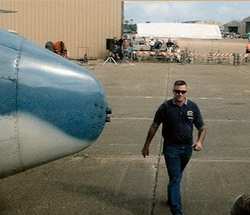 Here's the layout of passenger seats in this
beautiful Mitchell: two forward-facing seats directly in front of
the bomb bay, behind the flight deck and even with the side windows
that are abeam the 13 foot Hamilton Standard props; there are also
four seats in the rear of the plane. These four seats are arranged
so that the front pair have their backs up against the rear of the
bomb bay and they face the rear pair of seats, which are even with
the "waist" windows (in commercial aircraft this is called "club
seating"). The interior is lined with blue vinyl or Naugahyde,
matching the passenger seats.
Here's the layout of passenger seats in this
beautiful Mitchell: two forward-facing seats directly in front of
the bomb bay, behind the flight deck and even with the side windows
that are abeam the 13 foot Hamilton Standard props; there are also
four seats in the rear of the plane. These four seats are arranged
so that the front pair have their backs up against the rear of the
bomb bay and they face the rear pair of seats, which are even with
the "waist" windows (in commercial aircraft this is called "club
seating"). The interior is lined with blue vinyl or Naugahyde,
matching the passenger seats.
The rest of the "honorary crew" arrived: the first was Gerald
Jackson, about my age and from Louisiana. He had won a ride on the
B-17 in an LSFM drawing, and very smartly opted for a ride in the
PBJ when given the chance. The other gentleman was a seasoned
citizen, and I didn't have a chance to get his name or his story.
He looked like he had been a young man when this aircraft was fresh
out of the factory -- maybe he was rekindling an old love affair
with the Mitchell.
I let the other two guys take the front seats and I settled into
the right rear seat (right by the starboard waist window) and after
some fumbling around, got the seatbelt hooked up. Special-D was
parked parallel to the barricades that separated us from the
"vulgar" airshow crowd. I looked out of my window, and found Louise
in the crowd a hundred or so feet away and I naturally waved at
her. Then, I was surprised and pleased to see my friend, Paul
Johnson, making his way around the barricades, and away from the
crowd towards the rear hatch on the Mitchell. Paul was going to get
to ride, too! He buckled up in the seat opposite me, by the left
waist window. Soon, we swapped seats, so I could get the photos I'd
come to snap.
Under power.
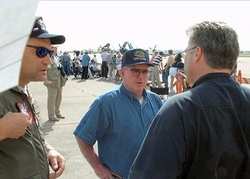 We all had headsets and plugged them in, so we
were able to hear the pilots running through their checklists, and
before we knew it, the prop on the first big Wright began to turn
(it was on Paul's side, so I didn't see it, but I did see the big
cloud of blue oil smoke develop and blast past his window as the
engine caught, and the prop blasted the smoke to the rear). A
minute or two later, "my" engine started in the same way. I took
off my headset for a minute, to hear the stereo Wright Double
Cyclone music -- it was WONDERFUL!!! Headset back on [it was also
deafening!], and after a few more items on the checklist were
ticked off, the pilots made a radio call and we began to taxi into
position in the runup area to do the prop and mag checks, etc. When
we had taxied about 200 feet and turned slightly to the left onto
the taxiway perpendicular to our runway, Runway 17, (note: even the
big guys do their runups into the wind) I noticed Paul looking out
his left-side window to the rear (the waist windows bulge
outward, and this enables you look to the front and rear of
the aircraft a little easier) and he turned around, made eye
contact with me (we didn't use the headsets for communication: the
pilots were rather busy trying to figure out who was landing at
GLS, which is Class E with no tower) and pointed to something that
I had not expected -- we had two single-engine planes taxiing
behind us: not just any two single engine planes, but the visiting
AD-4 Skyraider, Uncle Ho's Nightmare, and the Museum's
F4U-5N Corsair, Annie Mo.
We all had headsets and plugged them in, so we
were able to hear the pilots running through their checklists, and
before we knew it, the prop on the first big Wright began to turn
(it was on Paul's side, so I didn't see it, but I did see the big
cloud of blue oil smoke develop and blast past his window as the
engine caught, and the prop blasted the smoke to the rear). A
minute or two later, "my" engine started in the same way. I took
off my headset for a minute, to hear the stereo Wright Double
Cyclone music -- it was WONDERFUL!!! Headset back on [it was also
deafening!], and after a few more items on the checklist were
ticked off, the pilots made a radio call and we began to taxi into
position in the runup area to do the prop and mag checks, etc. When
we had taxied about 200 feet and turned slightly to the left onto
the taxiway perpendicular to our runway, Runway 17, (note: even the
big guys do their runups into the wind) I noticed Paul looking out
his left-side window to the rear (the waist windows bulge
outward, and this enables you look to the front and rear of
the aircraft a little easier) and he turned around, made eye
contact with me (we didn't use the headsets for communication: the
pilots were rather busy trying to figure out who was landing at
GLS, which is Class E with no tower) and pointed to something that
I had not expected -- we had two single-engine planes taxiing
behind us: not just any two single engine planes, but the visiting
AD-4 Skyraider, Uncle Ho's Nightmare, and the Museum's
F4U-5N Corsair, Annie Mo.
We've got company!
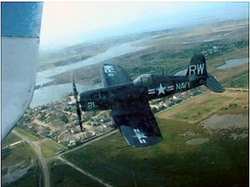 The presence of these two warbirds could mean only
one thing: formation flight! If there is a higher level in heaven
than your everyday, "you've been a good person, here is your harp"
level, then I'd just been elevated to that higher level, where you
get a harp and wings too (pun intended).
The presence of these two warbirds could mean only
one thing: formation flight! If there is a higher level in heaven
than your everyday, "you've been a good person, here is your harp"
level, then I'd just been elevated to that higher level, where you
get a harp and wings too (pun intended).
Our pilots finally made the radio call that our plane was taking
the active runway and I heard them say that they would taxi up a
little beyond the runway numbers, and not take off from the very
end of the runway, to give the two "little planes" a chance to form
up behind them for their formation takeoff. The next thing I knew,
the big Mitchell began to roll southward [the only way it could go,
ya know --ed] on Runway 17.
I was surprised by a number of things a few seconds after we
began our takeoff roll: it accelerated a lot more quickly than I'd
have thought; it was very smooth (I expected 3,400 HP of pure
Wright power to make the whole bird vibrate - after all, as noted
previously, these are the noisiest piston engines out there, or so
it seems) and we became airborne a lot faster than I'd thought. I
know that we were had a pretty good south wind, and when you get a
15 or 20 kt wind blowing right at you, you automatically have that
much airspeed before you begin rolling, but I was still
surprised.
In no time, we were free of Mother Earth, and from my vantage
point behind the left engine nacelle (which is bigger than many
airplane fuselages) I saw the rather huge left main gear retracting
rearwards into its compartment behind the big Wright.
I forget what the takeoff speed of the Mitchell is (but I'd bet
it's in the 100 - 120 kt range), and this madly rolling big tire
was still turning big-time when it disappeared into its compartment
and the doors closed behind it. I was going to try to remember to
ask the pilots if they tapped the brakes at some point just before
the gear was fully retracted, or if there was a mechanism inside
the compartment that stopped the rotation, or if it simply spun
itself down. (I didn't remember.)
30 Seconds Over Galveston...
As soon as the gear and flaps retracted (pretty much
simultaneously), we unfastened our seatbelts, unplugged the
headsets and began moving about the cabin. I had already taken
maybe ten photos from inside the PBJ by this time, but from that
point on, the photo-shooting frenzy began. Paul and I were looking
out the left waist window and he pointed down and behind us as we
climbed to our cruising altitude of 1,000 ft MSL (effectively 1,000
AGL -- Galveston is essentially at sea level).
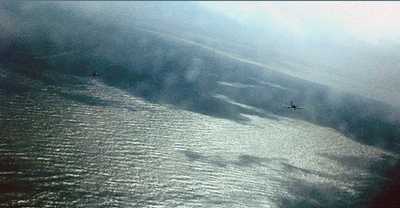
We were over the emerald green waters of the Gulf of Mexico,
with Galveston's Seawall Boulevard more or less parallel to our
rather far-out crosswind leg (what we did for our 20 minute flight
was to take off and fly three rather LARGE patterns on Scholes'
Runway 17) and climbing to meet up with us were the Skyraider (or
"Spad," as it was nicknamed years ago) and the Corsair. I knew that
my digital camera had only limited telephoto capabilities, but
nonetheless, I took a few photos of the two beautiful single-engine
aircraft gaining on our Mitchell. In one of these photos, the
broken cloud cover just overhead allowed for shafts of sunlight to
shine down on the Gulf, and Uncle
and Annie are nearly unseen when one looks at what is
an almost beautiful photograph: the Gulf, clouds, shadows of the
clouds on the water and sparkling reflections of the sun on the
waves.
Over-stimulated, and loving it...
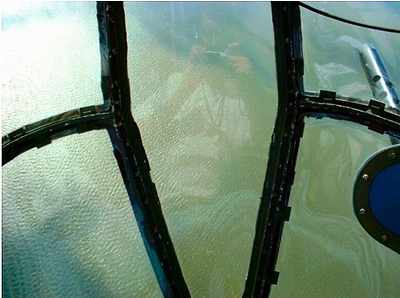
I must add that my flight on the Mitchell stimulated all of my
senses except for taste: sight (where do I begin?), sound (just
remove the headset for a moment and, WOW!), touch (the ride was
very smooth and the skill of the pilots kept my internal g-meter
from swinging past the 1.5 g mark -- I did, however, feel the power
of the big Wrights that I love so much -- they literally make the
whole airframe come alive) and lastly, smell -- old aircraft have a
smell all their own -- Special-D has her own wonderfully
special smell.
Enough about Nature and all that!
As our two formation partners winged their way up towards the
"mother ship," I took a number of photographs as they got closer. I
decided to go back to the tail gunner's position, where there was a
Plexiglas birdhouse canopy. By the time I crawled back there, the
two single-engine planes were getting nearer and nearer, and I
could see the pilot of each of them concentrating on the
Mitchell.
The "Spad," piloted by Rick Sharpe, pulled below and to the left
of the left vertical tail of the Mitchell and the Corsair, piloted
by Tom Gregory, III, mirrored this position on the other
side. I knew that I might have to shoot 10 photos to get one good
one, but I would have been happy to get just ONE good photo of each
plane that was getting closer and closer to my position in the
tail. The internal stubs of the fake .50 cal machine gun barrels in
the tail position of the Mitchell were digging into my chest as I
kneeled and did a little shooting of my own -- I didn't mind the
discomfort one bit!
"Enjoy your flight."
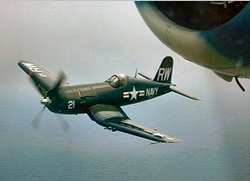 I somehow remembered the parting words of wisdom
from my much better half, who had reminded me to "...enjoy the
flight and don't just take photo after photo." I took a scan of
what the tail gunner would have seen as the Mitchell flew in combat
and decided that trying to photograph towards the front would not
be fruitful, because of the design of the Plexiglas canopy over my
head.
I somehow remembered the parting words of wisdom
from my much better half, who had reminded me to "...enjoy the
flight and don't just take photo after photo." I took a scan of
what the tail gunner would have seen as the Mitchell flew in combat
and decided that trying to photograph towards the front would not
be fruitful, because of the design of the Plexiglas canopy over my
head.
I climbed forward over the bomb bay, and the other three "guest
crewmen" were moving about the cabin as well! The guys from up
front wanted to see how things looked from the back, and vice
versa. We all wound up basically changing places and after taking
photos of the F4U from my vantage point at the window immediately
in front of the leading edge of the right wing (I was only about a
foot from a whirling propeller - cool!), I shifted to the window
directly across the fuselage and was able to take a number of
rather excellent photos of the AD-4 against the backdrop of the
Gulf of Mexico, Galveston Island and Galveston's harbor as we
continued flying the rather huge pattern for Runway 17 which was
several miles away from our "downwind leg." Later, I was surprised
to see, in the background behind the "Spad," sights of Galveston
that I had previously seen only from the ground: the Seawall, the
61st Street pier, on which I spent many, many hours as a kid,
fishing with my family, and of course the motels along the Seawall.
I also saw downtown Galveston, the harbor, Pelican Island, the
shipyards, the causeways (a pair of long bridges that connects
Galveston Island to the rest of Texas), and the pyramids that make
up Moody Gardens, which brings us right back to Scholes Field, the
next-door neighbor to Moody Gardens.
"Clambers With Camera" Gets Good Shots
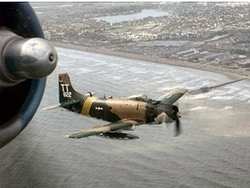 To get to my next duty position, after taking a
few photos of the flight deck and the pilots (I was surprised how
close together their seats were - it looked like they didn't have
any more shoulder room than light twins in which I've ridden) I did
the crawling thing again, this time to the expansive glass nose of
the Mitchell. Wow, what a view! We were out over the Gulf
again. I looked straight down and saw nothing but salt water 1,000
feet below.
To get to my next duty position, after taking a
few photos of the flight deck and the pilots (I was surprised how
close together their seats were - it looked like they didn't have
any more shoulder room than light twins in which I've ridden) I did
the crawling thing again, this time to the expansive glass nose of
the Mitchell. Wow, what a view! We were out over the Gulf
again. I looked straight down and saw nothing but salt water 1,000
feet below.
After "enjoying the flight" for maybe a minute, I got back to
the photography thing again. I was delighted to have the chance to
photograph the two smaller planes from yet another vantage point. I
must add that throughout the flight, once the other planes formed
on our Mitchell, it was as if they were attached to us by invisible
structural beams. The three planes flew as if one, as a result. My
wife said that we looked fantastic! I told her that I waved at her
on each pass, and she said that she was waving back.
Home, James...
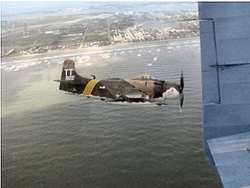 Soon, we were on our final circuit, and the seat
in the nose of the plane was not an official passenger seat -- so I
crawled rather awkwardly, and actually, for a few seconds, was
STUCK in the little tunnel that runs underneath the pilot's side of
the flight deck. After figuring out that I needed to stretch out
and crawl a little closer to the deck, I unstuck myself and arrived
in the seating area behind the flight deck.
Soon, we were on our final circuit, and the seat
in the nose of the plane was not an official passenger seat -- so I
crawled rather awkwardly, and actually, for a few seconds, was
STUCK in the little tunnel that runs underneath the pilot's side of
the flight deck. After figuring out that I needed to stretch out
and crawl a little closer to the deck, I unstuck myself and arrived
in the seating area behind the flight deck.
After a normal downwind and base leg of the pattern, throughout
which the pilots were busy running their checklists, setting
throttles, props, dropping flaps and gear, making radio calls, etc
(AND, I might add, like my instructors taught me, they had their
heads "on a swivel" looking for other traffic), we turned final and
were set up to land on Runway 17. The "Spad" and Corsair
landed on Runway 17 just before we did and by stretching my neck to
the limits, I was able to see the runway as we were on final and
short final. The pilots made a beautiful landing, and made good use
of dynamic braking, keeping the nose off of the runway 'til the
elevators couldn't hold it up any longer, allowing it to settle
gently as we rolled out after landing. I was in the left passenger
seat, and through my side window, I saw them turning off onto a
taxiway as we continued to roll out. Our pilots used the whole
runway and turned off at the end, saving the brakes, tires, and
gear.
A heroes' welcome...
As we taxied past airshow center, the crowd was waving and
smiling at us, as if we had just returned from a successful bombing
mission. There were a number of cameras pointed our way, too. Our
two 'little buddies' had already shut down and folded their wings
by the time we taxied past them.
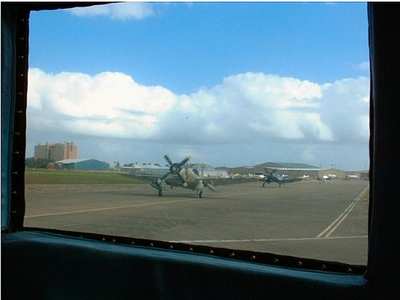
We were all smiles as we got off of the plane. Gerald, who is
also a pilot, had his Pilot's Log Book with him. He asked Al
Maxwell to log the flight for him, which he readily did. I asked Al
to hang around for a few minutes, if he would, so that I could run
out to the truck to get my own log book for him to enter the flight
in. He said that he'd be somewhere around the announcer's tent and
to look for him.
I saw my wife in the small crowd of people watching me walk
towards the barricades. She was shooting a photo of this '55 year
old kid,' with a grin from ear to ear... After fetching the only
"little black book" that I've ever had and making it back out to
the flight line, I found Al, who was having a pleasant visit with
an obvious admirer. Al filled out my logbook and gave me credit for
an introductory flight of 1.0 hours. It was a little of what one of
my CFI's called "pencil whipping," but if you went by Hobbs time,
it would have been somewhere between 30 minutes and 45 minutes, and
that's not too far from one hour.
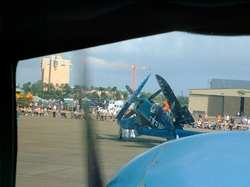 In closing, I hope that article somehow conveys
the absolutely priceless thrill of my getting to fly in, and with,
these aeronautical dinosaurs. I cannot begin to fully thank the
Lone Star Flight Museum people, especially Ralph Royce, Valarie
Barak, Bill Jolliffe, Paul Johnson, Al Maxwell…the list goes
on. I can only hope to have done a good enough job on this article
that they'll again invite me to fly on the B-17. I hope that every
ANN reader can send in a couple of bucks to the Lone Star Flight
Museum, earmarked for restoration of the big, beautiful PB4Y-2, or
the SBD Dauntless that is "recovering" from an accident, or for one
of their other restoration projects.
In closing, I hope that article somehow conveys
the absolutely priceless thrill of my getting to fly in, and with,
these aeronautical dinosaurs. I cannot begin to fully thank the
Lone Star Flight Museum people, especially Ralph Royce, Valarie
Barak, Bill Jolliffe, Paul Johnson, Al Maxwell…the list goes
on. I can only hope to have done a good enough job on this article
that they'll again invite me to fly on the B-17. I hope that every
ANN reader can send in a couple of bucks to the Lone Star Flight
Museum, earmarked for restoration of the big, beautiful PB4Y-2, or
the SBD Dauntless that is "recovering" from an accident, or for one
of their other restoration projects.
 ANN's Daily Aero-Term (04.26.24): DETRESFA (Distress Phrase)
ANN's Daily Aero-Term (04.26.24): DETRESFA (Distress Phrase) ANN's Daily Aero-Linx (04.26.24)
ANN's Daily Aero-Linx (04.26.24) Airborne 04.22.24: Rotor X Worsens, Airport Fees 4 FNB?, USMC Drone Pilot
Airborne 04.22.24: Rotor X Worsens, Airport Fees 4 FNB?, USMC Drone Pilot Airborne 04.24.24: INTEGRAL E, Elixir USA, M700 RVSM
Airborne 04.24.24: INTEGRAL E, Elixir USA, M700 RVSM Airborne-NextGen 04.23.24: UAVOS UVH 170, magni650 Engine, World eVTOL Directory
Airborne-NextGen 04.23.24: UAVOS UVH 170, magni650 Engine, World eVTOL Directory













